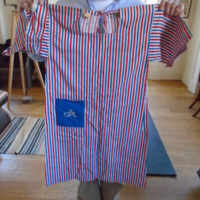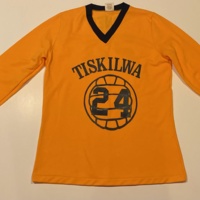Browse Exhibits (2 total)
Draped in Ideology: Clothing and Politics

American citizens have a long history of joining the fashionable and the political in order to convey ideologies to those around them. Today it is a common occurrence, especially during elections, to see individuals wearing campaign shirts, hats, or buttons. The five items in this exhibit are examples of how citizens promote their candidates during elections, local and national. Wearing these items may seem like a recent concept, but Americans have been using clothing to convey their personal beliefs since colonization. In the decades, leading up to the American Revolution fashion became simplified, not just out of necessity, but also as a social commentary on the changing ideals of independence and equality.Patriots embraced these changes in clothing by promoting homespun, local fabrics as a way to maintain autonomy from foreign manufacturing and in essence, the monarchy.
The history of campaign paraphernalia goes back to George Washington, when sew-on-buttons were manufactured to commemorate his 1789 inauguration. The election between Andrew Jackson and John Quincy Adams in 1828, forty years after Washington’s buttons, is hailed as the first presidential election where both men appealed to citizens on a national level. Jackson’s strategy was to hold events and give out campaign trinkets such as medals and snuffboxes. This tradition continued and only gained popularity among politicians and citizens in all levels of government, which can be seen in the wide array of political clothing within this exhibit.
Wearing campaign material is a way to endorse a particular candidate as well as displaying membership to certain communities, which can be advantageous for politicians when they want to promote their own social inclusivity. This is most apparent when politicians pander to certain demographics, as evident with the LGBT themed shirt in this exhibit, which features the Bernie Sanders logo in the recognizable LGBT rainbow, sold during his 2016 presidential campaign. Building communities are most evident in local elections, where clothing is given out to residents of districts and cities. In smaller communities wearing politicized clothing has even more power because there are often personal relationships with the candidate as seen with the Springfield, Illinois specific Langfelder Family items as well as the jacket worn by Mrs. Hunter during her husband’s 1978 campaign for the U.S. House of Representatives.
The act of providing campaign items has become a lucrative trade during elections. Not only are politicians able to market their candidacy by creating logos and catch phrases but by wearing these items citizens show their allegiance as well as promote their candidate. With the expansion of online shopping, Presidential candidates have been able to benefit from selling their own trinkets, usually returning the income to their campaign funds. This was pioneered by Barack Obama’s campaign, with the sale of merchandise earning the President’s 2012 bid for re-election, 40 million dollars.
Clothing as a means of political expression is such a powerful tool in America that in 1992 the Supreme Court ruled that allowing election merchandise to be worn at polling places was a means of voter influence. Citizen’s sartorial choices will always be an important aspect of elections and society. Even without candidate specific apparel, the “I Voted” stickers provided at polling places are enough to politicize any outfit, proving to others the fulfillment of one’s civic duty.
Apparel in American Education

These items tell a story. It is that of the elite status symbol becoming a memento of childhood and bonds. It is that of a celebration of self within a larger educational community. Unlike tokens that signify merely a group experience, these items, be it by number, jewel, or size, are crafted to the individual experience of a student. These pieces are present at some of life’s greatest achievements, they become a part of the person who wears them. The decor is meant to signify the identity and how the individual wishes to be viewed. Some of these important items, not too unlike wedding gowns, family pocket watches, and wedding rings, have significance in being passed down. They hold a part of the person with them. Education represents, for some, a simpler time in our history. For others, it is a time of progression and personal growth. These items are more than metal and cloth; they are memories, and they are tapestries of our lives that we carry on ourselves.
In this exhibit, we preserve something stronger than an artifact; we preserve a memory. Here, within databases and code, lies something warmer: a human experience. Now immortalized, these stories will continue to reach students who will continue to dance, to share, and to lead their own victories. This exhibit also speaks to the memories of those lucky enough to already possess them.
Subconscious disposition is embodied in our way of dress and the items that we choose to express ourselves. As we have grown in methods of thought and practice, ornamentation has changed to adhere to new traditions. Certain items do not carry, as they are formed and then realized as a kind of hindrance. We do not wear family crests, but the name of our family and of ourselves can fit on a hand. We cannot wear all sports gear at all times to display our belonging and communal spirit; we have condensed it to jackets and jerseys on our backs. We cannot drape ourselves elaborately in all things that have meaning. That is why these condensed items mean so much; they bear the weight of all the memories we cannot hold on our persons. We long for ways to evolve ourselves physically, and with the items in education, we are allowed to form the identity of our own choosing within a time of decision. We celebrate that time, that connectedness, and the ability to paint oneself with the effects of education. It exists beyond the classroom and halls to dance studios and football fields. It’s on our fingers, our feet, and our shoulders: education has truly left its mark on us.
